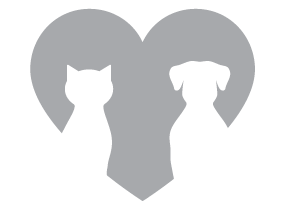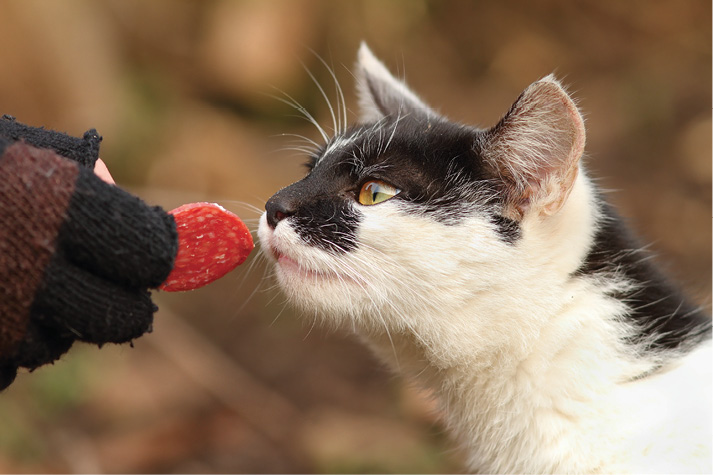
Chapter Twelve:
Feline Feeding Strategies

One of the best ways to ensure your cat achieves and maintains a healthy weight is to control his feeding schedule. If your kitten is still growing and needs to eat frequently, you can safely leave dry food for him to eat as he wishes. However, if you have noticed that your adult feline is packing on a few extra pounds, you might want to take a more controlled approach to his food access. Additionally, the feeding schedule you employ may differ depending on how many cats or how many different types of pets you have in your home. While previous content focused on what to feed your cat, this chapter is dedicated to providing recommendations on how to feed your pet to make sure he does not become overweight or obese.
Feeding Strategies
The feeding of your cat at any age should ensure that she receives all the vital nutrients she needs to thrive. The amount of food your cat needs to consume will depend on her size and energy output.
Generally speaking, you can use two square meals a day as a guideline for how often your cat should be fed. You will want to adjust the amount based on how much your cat seems to need to eat and which feeding method you want to employ. Consider how one of the following could best meet your cat’s dietary needs.
Portion-controlled feeding
You can control the amount of food (and calories) your cat eats by breaking the total amount of food you want them to consume in a day into two or three feedings. By consulting the portion instructions on manufactured cat foods, you can set aside the total amount of food you want your cat to consume in one day and then break it up into two or three small meals. If you are wondering how many calories your cat should consume, the Association for Pet Obesity Prevention recommends between 180 and 200 calories for the average 10 pound, spayed or neutered adult cat between the ages of one and seven (http://petobesityprevention.org). This recommendation is also based on the cat receiving less than 30 minutes of aerobic activity each day. If you keep your cat active, you can safely allow her to consume more calories.
The portion-control feeding strategy might be best for owners whose cats need to lose a little weight. You may have to use this method of feeding if you have multiple cats or other animals in the house that could steal the cat’s food if it is left out. If you employ this method, just make sure your cat is not going hungry or she could go about communicating her needs to you in ways that do not make you happy.
Free-choice feeding
With this method, you leave food in a bowl so that it is there whenever your cat wants it. This method works well when using dry food so that it will not spoil if left out. The best way to use this feeding strategy and still control caloric intake is to ensure that the amount of kibble being left out for free-choice feeding does not exceed the total recommended amount of calories for adult cats. This is also a good feeding method for kittens that need more calories and tend to get distracted easily, even when it comes to mealtime.
It also works in households where competition for food between cats or other pets is not a concern. You can use this plan unless you notice one cat being intimidated into not eating or your feline consuming too much food. If either of these incidents occurs, consider switching to or adding in another feeding strategy.
Timed feeding
As a blend of the first two strategies described, this method recommends that you put a portion of food out for your cat for a certain period of time. Once that period of time (30 minutes or so) is complete, you should remove whatever food remains uneaten.
Snacks
While it is fun to provide cats with treats, try to ensure their snacks do not make up more than five percent of their nutritional intake for a day. Snacks might have fun flavors, but they cannot serve as a nutritional substitute for a complete diet.
Food-dispensing toys
Cats fending for themselves outdoors might eat a dozen times a day. An indoor cat that can eat whenever they like do not burn the calories that would be worked off while a cat engages in a hunt. They also do not get the opportunity to engage their minds and bodies the same way their outdoor counterparts do.
While the indoor cat is clearly safer and will likely live a longer, healthier life, it is very easy for your indoor feline to become a large one. One way to help resolve this issue is to purchase a cat toy that mimics prey, but also dispenses food. Two recommendations I found online include Feeding Frenzy and Kong Company’s Cat Wobbler.
Feeding Success at Any Age
Cats can be finicky. This is partially their personality and partially because they have a keen sense of smell and taste. They might sense if food is not fresh or snub it if it is served at the wrong temperature (Edney 2006).
If you do not want to endure the frustration of serving your cat, only to have her walk away and ignore the food (or worse), try using the following strategies:
- Research prepared foods and make sure they have a good reputation and are vet recommended
- Do not feed your cat food intended for a dog or other pets
- Keep food bowls and water clean
- If you serve freshly cooked chicken or fish, make sure you remove all bones
- Do not put reheated food back into the refrigerator to save for later
Feeding a single cat or kitten
As mentioned previously, an adult cat needs to be provided two or three small meals a day (a kitten might need up to four) in compliance with the manufacturer’s recommendations in regards to portions (Edney). Whether you use a portion-control or free-choice feeding strategy, you should make sure that the daily amount of food your cat consumes meets their caloric needs without exceeding them. Make sure you factor in the calories they consume through treats (which should be limited even during a training period) when calculating the amount of food they consume each day.
Feeding in a multi-cat family
If you use a free-choice feeding strategy, you probably will not have any issues with feeding your multiple cats. However, you could run into issues where one cat consumes more food than they should. This could lead to weight and social problems for all of your cats.
If you notice one of your cats dominating the others when it comes to food, consider designating “assigned” spots for each cat and employing a feeding schedule. You can separate cats in bathrooms or crates (if they take to them) and allow them a specific period of time to eat their food. You might have to monitor your cats to make sure one of them does not intrude on the other’s space when they finish their own meal.

Once you establish a feeding structure in your home, your cats should adapt to it and mind it well. Just remember to be consistent and ensure your cats get the number of meals they need each day.
Feeding in a “blended” (cat and dog) house
First and foremost — as I have mentioned else ware in this book — a cat’s dietary needs simply do not match up to that of a dog’s. A cat is a carnivore and needs a high protein diet where a dog is an omnivore and might actually need to avoid a diet that is overly high in protein. Therefore, it is best not to allow your pets to eat each other’s food or to try to make one food work for both parties. This means that you will not be able to leave either pet’s food out for them to eat at their own leisure. You will want to arrange for scheduled feedings where you can keep your dog and cat separated to eat their meal in peace. If you can train your dog to eat in a crate or perhaps outside, that should create a natural separation while they eat. Conversely, you can feed them at different times of day, but you still might have to separate the animals so one does not bother the other at mealtime.
If you have to separate your pets during mealtime, be sure to give them plenty of time to eat and feed them several times a day.
Besides concerns of mal-nutrition for your cat, there are also ingredients in commercial dog food that might make your feline family member ill. In semi-moist dog food in particular, manufacturers sometimes use propylene glycol as a moisturizer, which is toxic for cats (Nestle 2010). This dog food ingredient is harmless to canines, but in cats it can cause Heinz body anemia (which can also occur if your cat ingests too much onion or garlic). If this type of anemia becomes too severe, it can become life threatening (www.askavetquestion.com). For that reason, even if it seems as if your cat would benefit from a meaty dog snack, be sure to keep them on a strictly feline-labeled diet.
Feeding Summary
No matter which feeding strategy you employ in your home, be sure to make sure your cat is feeling well-fed and cared for. If he seems to be hungry outside of the times you have set for his feeding, you might need to make some adjustments. While it is good to put your pets on a schedule — particularly one that works around your work and daily obligations — your cat may not always understand what you are trying to accomplish.
You may research diets, manufactured foods, and special recipes for your cat, only to discover that your pet has no interest in complying with your carefully selected feeding strategy. Be flexible and make sure your cat gets the nutrients he needs, whether they come from a raw diet or a standard commercial cat food line.
